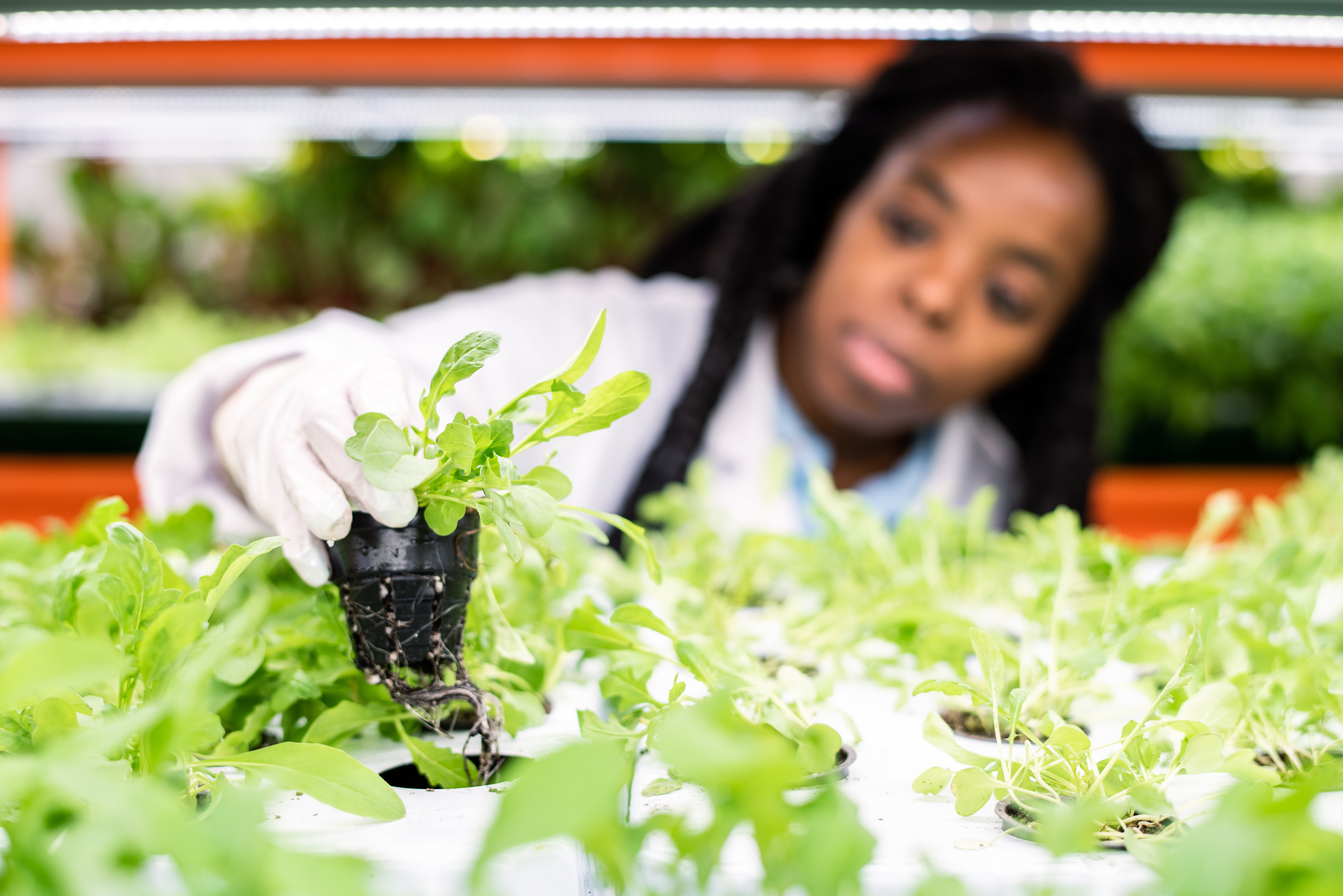
Kasha Dubaniewicz
Kasha is passionate about high-impact storytelling and believes in making positive changes that will lead to a better and happier world for all.
The World Wildlife Fund (WWF) recently published an Innovation Analysis report entitled Indoor Soilless Farming: Examining the Industry and Impacts of Controlled Environment Agriculture (CEA).
We got in touch with Julia Kurnik, Director of Innovation Startups - Markets, to take a closer look at the report's key findings and how these could have an impact on the future of CEA.
For those who haven’t read the full report yet, could you please summarise the main objectives you wanted to achieve through this research?
Absolutely. Part of my role as Director of Innovation Startups at the World Wildlife Fund (WWF) is to monitor major issues and trends facing food and agriculture. Indoor farming came to our attention due to its many potential environmental benefits. It offers low water use, low or no pesticide use, eliminates soil erosion, reduces post-harvest food loss, and has the potential to bring agriculture to food insecure communities.
However, it also faces a few large hurdles which has led to the industry staying rather niche so far, largely growing leafy greens and herbs often for higher-income populations. We decided to explore the industry more through our Innovation Analysis to better understand the hurdles and opportunities and what is coming down the line. Our goal is to see if we could help lower the energy footprint (and therefore both the environmental and financial costs) of these systems by taking advantage of stranded and underutilised assets and bringing together unique coalitions and partnerships.
The analysis helped set the stage for that actual coalition building. We want to boost the industry by overcoming the energy hurdle so that more varieties of produce can be grown profitably, letting the industry scale further and faster and bringing the benefits of indoor farming to more communities.
.jpg?width=3000&name=two-researchers-analyze-salad-plants-in-a-modern-g-D4HCNJ6-large%20(1).jpg)
What were the three biggest learnings? Did any of these surprise you?
I think I’d have to say how large the problem of excess heat is, how much energy source matters, and how disparate the industry remains. Going into this, I knew that energy footprint was a concern. It is simply logical that when you replace the sun with artificial lighting, even efficient LED lighting, that you will use a lot of energy. However, I didn’t realise that a major part of the energy use comes not from running the actual lights but cooling the farm because of those lights. Even with efficient LEDs, enough heat is given off from the sheer number of lights packed in a tight space that they often end up cooling farms in the middle of winter. Of course, this also meant they now have a lever to pull in lowering energy footprints. This was surprising to me.
I was also intrigued to find out how much energy source matters. We concentrate so much on the actual energy footprint, but our Life-Cycle Assessment (LCA) analysis shows that many harmful effects come not from the actual energy source but depend on how that energy is made. Even if someone is using a less efficient farming system, if it is done in a place with a cleaner energy mix (like California, in our LCA) it can still end up more environmentally friendly than an efficient system that is dependent on dirtier energy production.
Finally, the industry remains really fragmented even as it grows. Unlike the previous two, I wasn’t surprised by this, but I think it’s an important learning to highlight. Many farms are trying to invest in creating their own technology, their own grow recipes, their own lighting, and more, while also trying to be farms. I think there is a missed opportunity for shared best practices and industry standards that might help the entire industry scale.
Many people associate WWF with wildlife conservation. What’s the connection to CEA and agriculture?
Yes, many people end up disappointed that I do not know more about pandas! But bamboo is a very environmentally friendly crop so perhaps I can explore growing that next… WWF did start with a commitment to conserve nature and wildlife. However, I like to think of it as expanding concentric circles.
That commitment remains, but the second half of our mission is about reducing the most pressing threats to the diversity of life on Earth – and the way we currently produce our food is one of those threats. You cannot make gains in environmental conservation without protecting people who depend on the land and considering working lands, like farms. Agriculture is one of the largest human impacts on nature and climate change but also an integral part of our life.

When looking at the overall impact of the different growing methods, the report didn’t include several indirect environmental factors associated with conventional agriculture, such as dams and water/air pollution. Could you explain the reason for this and how, if included, this may have affected the overall scoring?
It’s a great and important question. Unfortunately, with any LCA, boundaries need to be drawn to complete the work but they will always leave something out. In our case, we decided to look more closely at the farming systems themselves because the repercussions could be endless. While we note that in our report, it would have made completing our research nearly impractical.
You point to several really important environmental factors. There are others around initial land conversion and water table depletion that we also didn’t include. Those happened long ago rather than right now as we grow our food in California. However, we also had to leave out factors on the side of indoor farming. We did not include building construction/renovation or the footprint of manufacturing the permanent equipment and technology that is used in the grow systems. It is hard to say how this would have balanced out but I hope we can look into this more at some point.
The report makes it clear that there are major differences of energy sources within different regions of the US, which affected the overall environmental impact scoring of CEA grow sites in these locations. Are there any plans to include other regions within the US – or even elsewhere in the world – in future reports/research?
Yes, this ended up having a very large effect on our LCA. I hope it acts as a spur to consider innovative energy solutions. We are doing that in our project in St. Louis. We are not only looking at using stranded and underutilised assets to lower the energy footprint, but how to use those assets to make the energy source greener.
Our goal would be to share those learnings and see innovation happen elsewhere, too. However, at this point, we do not have plans to conduct another LCA looking at another region or country. It is always possible, but our hope is that this serves to start conversations like these and avoid reinventing the wheel.
While there are some clear challenges facing CEA, mainly around energy consumption, these types of grow sites received good scores for land and water use. Could you explain why this is especially important for setting up a grow facility in St. Louis?
Yes, the industry definitely has some strong benefits. In truth, some of these benefits may be even more beneficial for areas outside of the US. We have been lucky enough here to have a breadbasket that can produce the food our country needs. I think that is some of the reason we have seen other regions innovate faster around indoor farming.
There has been a lot of advancement in places where land is especially valuable (such as islands) and where water is scarce (such as the Middle East). In our case, we didn’t actually choose St. Louis specifically for its connection to land and water use. Instead, we looked broadly at the US to find a city that had a million or more people, so there was a strong market for food and ability to serve people with a short distribution supply chain, with stranded and underutilised assets, seasonality so that food couldn’t already be grown year-round, and had strong potential partner universities and community foundations. This yielded about ten cities.
At that point, we looked a little more closely and were enthusiastic about St. Louis because of its exceptional plant science expertise. It has one of the highest concentrations of plant scientists in the world. We are excited about the potential for seeds optimised for indoor growth to drive down the environmental footprint and cost of food grown indoors and wanted to come to St. Louis to build on that knowledge base.
-1.jpg?width=3000&name=shutterstock_1028738140-large%20(1)-1.jpg)
What role can technology play to reduce the impacts identified in the report and what can be done to incentivise growers to invest?
I’m excited about some of the technologies coming down the pipeline. There are innovations in grow technique, in automation and precision applications, and in lighting and energy use. I am personally fascinated by the use of fibre optics and daylighting to actually bring sunlight inside. It is still very expensive, but I had no idea that technology even existed before this project. I do believe that many of these technologies could be game changing, but they aren’t there yet, and the gains would need to be shared by the industry to really see an effect.
I think growers are already incentivised to invest but they may not be the best ones to do so. The energy footprint is not only an environmental problem but a financial one. There is little technical limitation on what these farms can grow. However, it is not cost effective to do so. The energy required to grow fruiting crops, for example, means they generally will not be profitable to farms or could only be sold at really high prices to consumers who can afford to and are interested in paying a premium.
However, I don’t believe it is efficient for every farm to put resources into these technologies. It means there will be no economies of scale, no ability to build on each other’s work, and lots of repeated time, effort, and money. We hope to promote knowledge sharing across the industry, or even a potential Center of Excellence, to help do some of this technological research and share the gains. All farms will benefit from better technology.
What do you think needs to be done to encourage CEA growers to consider the full environmental impact of this growing method and what small steps could growers take today to start on this journey?
I think that many CEA growers entered this space because of their passion for and commitment to social and environmental concerns for our food and agriculture system today. It means many are deeply committed to improving their footprint and reaching more people at affordable rates. That is an important start and without that base, much of this work would not be possible. I hope our LCA continues steps in that direction. I’d love to see us be able to update our LCA down the line with pooled data from a variety of farms to see if gains have been made and to share opportunities and hurdles.
I also think it’s important to consider the full scope of impacts across the entire manufacturing process of equipment and up and downstream of the supply chain of these farms. I think there is growing awareness of these impacts - I’m referring to Scope 3 emissions - and continued conversation will be necessary for iterative improvement.
Do you think there needs to be more knowledge sharing amongst CEA growers to understand technological advantages and information on how to achieve increased sustainability in a way that’s commercially viable?
Absolutely. I believe that beginning knowledge sharing on issues that are less competitive would be beneficial. We certainly do not expect farms to share their 'secret sauce' but there might be some key areas, perhaps around standardisation, where everyone would benefit from working together. We’ve helped this happen in other industries, such as salmon aquaculture and the Global Salmon Initiative, and know that an entire industry can benefit, especially an early-stage one, through collaboration.

Your report lists food safety and supply chain resilience as two major benefits associated with hydroponics. Could you explain why this is important – especially through the filter of COVID-19?
What a great question. Obviously, when we started this project, COVID-19 had not yet emerged in humans. We were examining a food safety and supply chain system that we felt was already extremely insecure and broken in many places. Currently, we produce more food than we need as a planet but it isn’t getting to all of the people who need it most.
In the US, we’re wasting up to 40-50% of our fresh produce, there are frequent foodborne disease outbreaks and recalls, and these issues, especially when paired with major events like COVID-19, can quickly disrupt our existing systems. Unfortunately, those foundational concerns about the resilience of our systems have come to life.
We saw bare supermarket shelves while people were cooking more at home due to COVID-19, yet lack of food wasn’t the problem. While people were panic buying in stores, farmers were dumping milk and ploughing produce back into their fields. Some markets, like restaurants and schools, shut down abruptly and farmers weren’t able to shift and find alternative markets to get their harvests to people.
Indoor farming is not going to solve all of this. There will always be food grown outdoors and it would not make sense to try to grow all food indoors in all locations. Yet we do feel that this is one potential solution of many that will help address these hurdles. There could be a balance of global and local food supply that buffers the resilience of any system. Indoor farming can occur in major population centres, which is why we started our project by looking at cities - where a shorter supply chain is much harder to disrupt and could provide fresh food with less waste.
It also offers the ability to grow food in places that cannot otherwise do so. That is a potential game changer for places that currently import most or all their food. Finally, it can be scaled up or down as needed. Food grows extremely quickly in these systems - far faster than outdoors due to the optimisation, precision, and control exerted. CEA systems don’t need to replace all supply chains but can help augment them while also serving as a backup in the event of future uncertainty or disastrous event.




Submit a comment